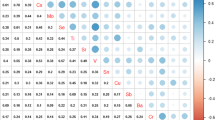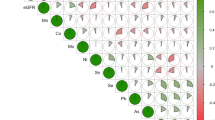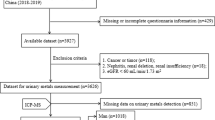Abstract
Previous studies have indicated that exposure to a single toxic metal can cause renal tubular damage, while evidence about the effects of multimetal exposure on renal tubular damage is relatively limited. We aimed to evaluate the relationships of multimetal coexposure with renal tubular damage in adults in heavy metal-polluted rural regions of China. A cross-sectional study of 1918 adults in China’s heavy metal-contaminated rural regions was conducted. Inductively coupled plasma–mass spectrometry (ICP–MS) was used to measure the plasma levels of 18 metals in participants, and immune turbidimetry was used to measure sensitive biological indicators, reflecting renal tubular damage (including retinol-binding protein and β2-microglobulin). Least absolute shrinkage and selection operator (LASSO) penalized regression analysis, logistic and linear regression analysis, restricted cubic spline (RCS) regression analysis and the Bayesian kernel machine regression (BKMR) method were used to explore associations of multimetal coexposure with renal tubular damage risk or renal tubular damage indicators. Plasma selenium, cadmium, arsenic, and iron were identified as the main plasma metals associated with renal tubular damage risk after dimensionality reduction. Multimetal regression models showed that selenium was positively associated, and iron was negatively associated with renal tubular damage risk or its biological indicators. Multimetal RCS analyses additionally revealed a non-linear relationship of selenium with renal tubular damage risk. The BKMR models showed that the metal mixtures were positively associated with biological indicators of renal tubular damage when the metal mixtures were above the 50th percentile of concentration. Our findings indicated that natural exposure to high levels of multimetal mixtures increases the risk of renal tubular damage. Under the conditions of multimetal exposure, selenium was positively associated, and iron was negatively associated with renal tubular damage risk or its biological indicators.



Similar content being viewed by others
Data availability
Not applicable.
References
Aitio A, Bernard A, Fowler BA, Nordberg GF (2007) Chapter 4: biological monitoring and biomarkers. In: Nordberg GF, Fowler BA, Nordberg M, Friberg LT (eds) Handbook on the toxicology of metals, 3rd edn. Elsevier, New York, NY, USA, p 75
Akesson A, Lundh T, Vahter M, Bjellerup P, Lidfeldt J, Nerbrand C et al (2005) Tubular and glomerular kidney effects in Swedish women with low environmental cadmium exposure. Environ Health Perspect 113:1627–1631. https://doi.org/10.1289/ehp.8033
Barbier O, Jacquillet G, Tauc M, Cougnon M, Poujeol P (2005) Effect of heavy metals on, and handling by, the kidney. Nephron Physiol 99:105–110. https://doi.org/10.1159/000083981
Barceloux DG (1999) Selenium. J Toxicol Clin Toxicol 37:145–172. https://doi.org/10.1081/clt-100102417
Battin EE, Brumaghim JL (2009) Antioxidant activity of sulfur and selenium: a review of reactive oxygen species scavenging, glutathione peroxidase, and metal-binding antioxidant mechanisms. Cell Biochem Biophys 55:1–23. https://doi.org/10.1007/s12013-009-9054-7
Bikbov B, Purcell CA, Levey AS, Smith M, Abdoli A, Abebe M et al (2020) Global, regional, and national burden of chronic kidney disease, 1990–2017: a systematic analysis for the global burden of disease study 2017. Lancet 395:709–733. https://doi.org/10.1016/S0140-6736(20)30045-3
Bobb JF, Henn BC, Valeri L, Coull BA (2018) Statistical software for analyzing the health effects of multiple concurrent exposures via Bayesian kernel machine regression. Environ Health 17:67. https://doi.org/10.1186/s12940-018-0413-y
Bork U, Lee WK, Kuchler A, Dittmar T, Thévenod F (2010) Cadmium-induced DNA damage triggers G2/M arrest via chk1/2 and cdc2 in p53-deficient kidney proximal tubule cells. Am J Physiol Renal Physiol 298:255–265. https://doi.org/10.1152/ajprenal.00273.2009
Braun JM, Gennings C, Hauser R, Webster TF (2016) What can epidemiological studies tell us about the impact of chemical mixtures on human health? Environ Health Perspect 124:A6–A9. https://doi.org/10.1289/ehp.1510569
Cai X, Wang C, Yu W, Fan W, Wang S, Shen N et al (2016) Selenium exposure and cancer risk: an updated meta-analysis and meta-regression. Sci Rep 6:19213. https://doi.org/10.1038/srep19213
Chou X, Ding F, Zhang X, Ding X, Gao H, Wu Q et al (2019) Sirtuin-1 ameliorates cadmium-induced endoplasmic reticulum stress and pyroptosis through XBP-1s deacetylation in human renal tubular epithelial cells. Arch Toxicol 93:965–986. https://doi.org/10.1007/s00204-019-02415-8
Cui X, Cheng H, Liu X, Giubilato E, Critto A, Sun H et al (2018) Cadmium exposure and early renal effects in the children and adults living in a tungsten-molybdenum mining areas of South China. Environ Sci Pollut Res Int 25:15089–15101. https://doi.org/10.1007/s11356-018-1631-0
Cukierski MJ, Willhite CC, Lasley BL, Hendrie TA, Book SA, Cox DN et al (1989) 30-day oral toxicity study of L-selenomethionine in female long-tailed macaques (Macaca fascicularis). Fundam Appl Toxicol 13:26–39. https://doi.org/10.1016/0272-0590(89)90304-7
Du Y, Chen L, Ding P, Liu L, He Q, Chen B et al (2019) Different exposure profile of heavy metal and health risk between residents near a Pb-Zn mine and a Mn mine in Huayuan county, South China. Chemosphere 216:352–364. https://doi.org/10.1016/j.chemosphere.2018.10.142
Eckhert CD, Lockwood MK, Hsu MH, Ho J, Kang R (1992) Microvascular changes in rat glomeruli as a consequence of small differences in selenium exposure. Exp Mol Pathol 57:222–234. https://doi.org/10.1016/0014-4800(92)90013-2
Ekong EB, Jaar BG, Weaver VM (2006) Lead-related nephrotoxicity: a review of the epidemiologic evidence. Kidney Int 70:2074–2084. https://doi.org/10.1038/sj.ki.5001809
Faure P (2003) Protective effects of antioxidant micronutrients (vitamin E, zinc and selenium) in type 2 diabetes mellitus. Clin Chem Lab Med 41:995–998. https://doi.org/10.1515/cclm.2003.152
Hong F, Jin T, Zhang A (2004) Risk assessment on renal dysfunction caused by co-exposure to arsenic and cadmium using benchmark dose calculation in a Chinese population. Biometals 17:573–580. https://doi.org/10.1023/b:biom.0000045741.22924.d8
Huang M, Chen J, Yan G, Yang Y, Luo D, Chen X et al (2021) Plasma titanium level is positively associated with metabolic syndrome: a survey in China’s heavy metal polluted regions. Ecotoxicol Environ Saf 208:111435. https://doi.org/10.1016/j.ecoenv.2020.111435
Iwata K, Saito H, Moriyama M, Nakano A (1993) Renal tubular function after reduction of environmental cadmium exposure: a ten-year follow-up. Arch Environ Health 48:157–163. https://doi.org/10.1080/00039896.1993.9940814
Jalili C, Kazemi M, Cheng H, Mohammadi H, Babaei A, Taheri E et al (2021) Associations between exposure to heavy metals and the risk of chronic kidney disease: a systematic review and meta-analysis. Crit Rev Toxicol 51:165–182. https://doi.org/10.1080/10408444.2021.1891196
Jamakala O, Rani UA (2015) Amelioration effect of zinc and iron supplementation on selected oxidative stress enzymes in liver and kidney of cadmium-treated male albino rat. Toxicol Int 22:1–9. https://doi.org/10.4103/0971-6580.172289
Jha V, Garcia-Garcia G, Iseki K, Li Z, Naicker S, Plattner B et al (2013) Chronic kidney disease: global dimension and perspectives. Lancet 382:260–72. https://doi.org/10.1016/s0140-6736(13)60687-x
Johnson VJ, Tsunoda M, Sharma RP (2000) Increased production of proinflammatory cytokines by murine macrophages following oral exposure to sodium selenite but not to seleno-L-methionine. Arch Environ Contam Toxicol 39:243–250. https://doi.org/10.1007/s002440010101
Johri N, Jacquillet G, Unwin R (2010) Heavy metal poisoning: the effects of cadmium on the kidney. Biometals 23:783–792. https://doi.org/10.1007/s10534-010-9328-y
Kan X, Dong Y, Feng L, Zhou M, Hou H (2021) Contamination and health risk assessment of heavy metals in China’s lead–zinc mine tailings: a meta–analysis. Chemosphere 267:128909. https://doi.org/10.1016/j.chemosphere.2020.128909
Karmaus W, Dimitrov P, Simeonov V, Tsolova S, Bonev A, Georgieva R (2008) Metals and kidney markers in adult offspring of endemic nephropathy patients and controls: a two-year follow-up study. Environ Health 7:11. https://doi.org/10.1186/1476-069x-7-11
Kim HR, Lee KY, Ahn SG, Lee BH, Jung KT, Yoon JH et al (2015) Transcriptional regulation, stabilization, and subcellular redistribution of multidrug resistance-associated protein 1 (MRP1) by glycogen synthase kinase 3αβ: novel insights on modes of cadmium-induced cell death stimulated by MRP1. Arch Toxicol 89:1271–1284. https://doi.org/10.1007/s00204-014-1381-9
Klotz K, Weistenhöfer W, Drexler H (2013) Determination of cadmium in biological samples. Met Ions Life Sci 11:85–98. https://doi.org/10.1007/978-94-007-5179-8_4
Kuruppu D, Hendrie HC, Yang L, Gao S (2014) Selenium levels and hypertension: a systematic review of the literature. Public Health Nutr 17:1342–1352. https://doi.org/10.1017/s1368980013000992
Lemire M, Philibert A, Fillion M, Passos CJS, Guimarães JRD, Barbosa FJ, Mergler D (2012) No evidence of selenosis from a selenium-rich diet in the Brazilian Amazon. Environ Int 40:128–136. https://doi.org/10.1016/j.envint.2011.07.005
Li XT, Yu PF, Gao Y, Guo WH, Wang J, Liu X et al (2017) Association between plasma metal levels and diabetes risk: a case-control study in China. Biomed Environ Sci 30:482–491. https://doi.org/10.3967/bes2017.064
Li X, Zhao Z, Ye Y, Xiang W, Li X (2018) Heavy metal accumulation and its spatial distribution in agricultural soils: evidence from Hunan Province, China. RSC Adv 8(19):10665–10672. https://doi.org/10.1039/c7ra12435j
Liang Y, Lei L, Nilsson J, Li H, Nordberg M, Bernard A et al (2012) Renal function after reduction in cadmium exposure: an 8 year follow-up of residents in cadmium-polluted areas. Environ Health Perspect 120:223–228. https://doi.org/10.1289/ehp.1103699
Lin YS, Ho WC, Caffrey JL, Sonawane B (2014) Low serum zinc is associated with elevated risk of cadmium nephrotoxicity. Environ Res 134:33–38. https://doi.org/10.1016/j.envres.2014.06.013
Liu ZH (2013) Nephrology in China. Nat Rev Nephrol 9:523–528. https://doi.org/10.1038/nrneph.2013.146
Liu Y, Yuan Y, Xiao Y, Li Y, Yu Y, Mo T et al (2020) Associations of plasma metal concentrations with the decline in kidney function: a longitudinal study of Chinese adults. Ecotoxicol Environ Saf 189:110006. https://doi.org/10.1016/j.ecoenv.2019.110006
Lv Y, Xie L, Dong C, Yang R, Long T, Yang H et al (2021) Co-exposure of serum calcium, selenium and vanadium is nonlinearly associated with increased risk of type 2 diabetes mellitus in a Chinese population. Chemosphere 263:128021. https://doi.org/10.1016/j.chemosphere.2020.128021
Nagy G, Benko I, Kiraly G, Voros O, Tanczos B, Sztrik A et al (2015) Cellular and nephrotoxicity of selenium species. J Trace Elem Med Biol 30:160–170. https://doi.org/10.1016/j.jtemb.2014.12.011
Nair AR, Lee WK, Smeets K, Swennen Q, Sanchez A, Thévenod F et al (2015) Glutathione and mitochondria determine acute defense responses and adaptive processes in cadmium-induced oxidative stress and toxicity of the kidney. Arch Toxicol 89:2273–2289. https://doi.org/10.1007/s00204-014-1401-9
Nordberg GF, Jin T, Hong F, Zhang A, Buchet JP, Bernard A (2005) Biomarkers of cadmium and arsenic interactions. Toxicol Appl Pharmacol 206:191–197. https://doi.org/10.1016/j.taap.2004.11.028
Orr SE, Bridges CC (2017) Chronic kidney disease and exposure to nephrotoxic metals. Int J Mol Sci 18:1039. https://doi.org/10.3390/ijms18051039
Piscator M (1984) Long-term observations on tubular and glomerular function in cadmium-exposed persons. Environ Health Perspect 54:175–179. https://doi.org/10.1289/ehp.8454175
Prozialeck WC, Edwards JR (2010) Early biomarkers of cadmium exposure and nephrotoxicity. Biometals 23:793–809. https://doi.org/10.1007/s10534-010-9288-2
Rayman MP, Stranges S (2013) Epidemiology of selenium and type 2 diabetes: can we make sense of it? Free Radic. Biol Med 65:1557–1564. https://doi.org/10.1016/j.freeradbiomed.2013.04.003
Robles-Osorio ML, Sabath-Silva E, Sabath E (2015) Arsenic-mediated nephrotoxicity. Ren Fail 37:542–547. https://doi.org/10.3109/0886022x.2015.1013419
Scott N, Hatlelid KM, MacKenzie NE, Carter DE (1993) Reactions of arsenic (III) and arsenic(V) species with glutathione. Chem Res Toxicol 6:102–106. https://doi.org/10.1021/tx00031a016
Shelley R, Kim NS, Parsons P, Lee BK, Jaar B, Fadrowski J et al (2012) Associations of multiple metals with kidney outcomes in lead workers. Occup Environ Med 69:727–735. https://doi.org/10.1136/oemed-2012-100765
Soderland P, Lovekar S, Weiner DE, Brooks DR, Kaufman JS (2010) Chronic kidney disease associated with environmental toxins and exposures. Adv Chronic Kidney Dis 17:254–264. https://doi.org/10.1053/j.ackd.2010.03.011
Tsai TL, Kuo CC, Pan WH, Chung YT, Chen CY, Wu TN et al (2017) The decline in kidney function with chromium exposure is exacerbated with co-exposure to lead and cadmium. Kidney Int 92:710–720. https://doi.org/10.1016/j.kint.2017.03.013
Ullah H, Liu G, Yousaf B, Ali MU, Irshad S, Abbas Q et al (2019) A comprehensive review on environmental transformation of selenium: recent advances and research perspectives. Environ Geochem Health 41:1003–1035. https://doi.org/10.1007/s10653-018-0195-8
van Swelm RPL, Wetzels JFM, Swinkels DW (2020) The multifaceted role of iron in renal health and disease. Nat Rev Nephrol 16:77–98. https://doi.org/10.1038/s41581-019-0197-5
Vinceti M, Maraldi T, Bergomi M, Malagoli C (2009) Risk of chronic low-dose selenium overexposure in humans: insights from epidemiology and biochemistry. Rev Environ Health 24:231–248. https://doi.org/10.1515/reveh.2009.24.3.231
Vinceti M, Filippini T, Cilloni S, Bargellini A, Vergoni AV, Tsatsakis A et al (2017) Health risk assessment of environmental selenium: emerging evidence and challenges (Review). Mol Med Rep 15:3323–3335. https://doi.org/10.3892/mmr.2017.6377
Vinceti M, Filippini T, Wise LA (2018) Environmental selenium and human health: an update. Curr Environ Health Rep 5:464–485. https://doi.org/10.1007/s40572-018-0213-0
Vinceti M, Filippini T, Rothman KJ (2018) Selenium exposure and the risk of type 2 diabetes: a systematic review and meta-analysis. Eur J Epidemiol 33:789–810. https://doi.org/10.1007/s10654-018-0422-8
Vinceti M, Chawla R, Filippini T, Dutt C, Cilloni S, Loomba R et al (2019) Blood pressure levels and hypertension prevalence in a high selenium environment: results from a cross-sectional study. Nutr Metab Cardiovasc Dis 29:398–408. https://doi.org/10.1016/j.numecd.2019.01.004
Xu X, Nie S, Ding H, Hou FF et al (2018) Environmental pollution and kidney diseases. Nat Rev Nephrol 14:313–324. https://doi.org/10.1038/nrneph.2018.11
Yang F, Yi X, Guo J, Xu S, Xiao Y, Huang X et al (2019) Association of plasma and urine metals levels with kidney function: a population-based cross-sectional study in China. Chemosphere 226(321–328):2019. https://doi.org/10.1016/j.chemosphere.2019.03.171
Zachara BA (2015) Selenium and selenium-dependent antioxidants in chronic kidney disease. Adv Clin Chem 68:131–151. https://doi.org/10.1016/bs.acc.2014.11.006
Zhang L, Wang F, Wang L et al (2012) Prevalence of chronic kidney disease in China: a cross-sectional survey. Lancet 379:815–822. https://doi.org/10.1016/S0140-6736(12)60033-6
Zhang X, Liu C, Guo J, Song Y (2016) Selenium status and cardiovascular diseases: meta-analysis of prospective observational studies and randomized controlled trials. Eur J Clin Nutr 70:162–169. https://doi.org/10.1038/ejcn.2015.78
Zhang C, Lin T, Nie G, Hu R, Pi S, Wei Z et al (2021) Cadmium and molybdenum co-induce pyroptosis via ROS/PTEN/PI3K/ AKT axis in duck renal tubular epithelial cells. Environ Pollut 272:116403. https://doi.org/10.1016/j.envpol.2020.116403
Zwolak I (2020) The role of selenium in arsenic and cadmium toxicity: an updated review of scientific literature. Biol Trace Elem Res 193:44–63. https://doi.org/10.1007/s12011-019-01691-w
Acknowledgements
The authors thank all the participants for their invaluable contributions.
Funding
This work was supported by the National Natural Science Foundation of China (82173905 and 82070759) and the Ministry of Science and Technology of China (2015FY111100).
Author information
Authors and Affiliations
Contributions
Jingjing Quan: conceptualization, methodology, data curation, writing — original draft, writing — review and editing, visualization, and project administration. Yan Li: conceptualization, methodology, data curation, writing — original draft, writing — review and editing, and project administration. Hong Yuan: conceptualization, resources, writing — review and editing. Yao Lu: conceptualization, methodology, resources, writing — review and editing, and project administration. Bin Yi: conceptualization, methodology, resources, writing — review and editing, and project administration. Xiang Chen: conceptualization, methodology, resources, writing — review and editing, and project administration. Zhijun Huang: conceptualization, methodology, resources, writing — review and editing, and project administration.
Corresponding author
Ethics declarations
Ethical approval and consent to participate
The study was approved by the Medical Ethics Committee of the Xiangya Hospital, Central South University, and all the participants have signed the informed consent.
Consent for publication
All of the authors have read and approved the paper.
Competing interests
The authors declared no competing interests.
Additional information
Responsible Editor: Lotfi Aleya
Publisher's Note
Springer Nature remains neutral with regard to jurisdictional claims in published maps and institutional affiliations.
Supplementary Information
Below is the link to the electronic supplementary material.


Rights and permissions
Springer Nature or its licensor (e.g. a society or other partner) holds exclusive rights to this article under a publishing agreement with the author(s) or other rightsholder(s); author self-archiving of the accepted manuscript version of this article is solely governed by the terms of such publishing agreement and applicable law.
About this article
Cite this article
Quan, J., Li, Y., Shen, M. et al. Coexposure to multiple metals and renal tubular damage: a population-based cross-sectional study in China’s rural regions. Environ Sci Pollut Res 30, 52421–52432 (2023). https://doi.org/10.1007/s11356-023-25909-6
Received:
Accepted:
Published:
Issue Date:
DOI: https://doi.org/10.1007/s11356-023-25909-6




